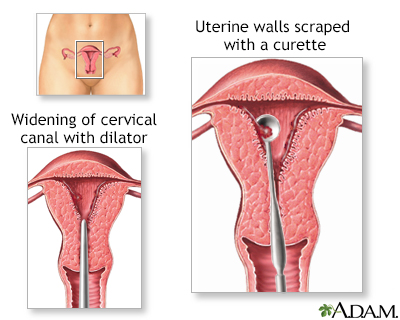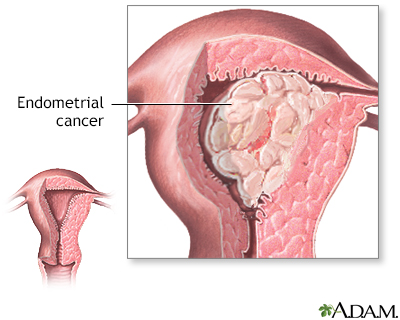Pregnancy SmartSiteTM
Endometrial adenocarcinoma; Uterine adenocarcinoma; Uterine cancer; Adenocarcinoma - endometrium; Adenocarcinoma - uterus; Cancer - uterine; Cancer - endometrial; Uterine corpus cancer DefinitionEndometrial cancer is cancer that starts in the endometrium, the lining of the uterus (womb). CausesEndometrial cancer is the most common type of uterine cancer. The exact cause of endometrial cancer is not known. An increased level of estrogen hormone may play a role. This stimulates the buildup of the lining of the uterus. This can lead to abnormal overgrowth of the endometrium and cancer. Most cases of endometrial cancer occur between the ages of 60 and 70. A few cases may occur before age 40. The following factors related to your hormones increase your risk for endometrial cancer:
Women with the following conditions also seem to be at a higher risk for endometrial cancer:
SymptomsSymptoms of endometrial cancer include:
Exams and TestsDuring the early stages of disease, a pelvic exam is often normal.
Based on your symptoms and other findings, other tests may be needed. Some can be done in your health care provider's office. Others may be done at a hospital or surgical center:
If cancer is found, imaging tests may be done to see if the cancer has spread to other parts of the body. This is called staging. Stages of endometrial cancer are:
Cancer is also described as grade 1, 2, or 3. Grade 1 is the least aggressive, and grade 3 is the most aggressive. Aggressive means that the cancer grows and spreads quickly. TreatmentTreatment options include:
Surgery to remove the uterus (hysterectomy) may be done in women with early stage 1 cancer. The surgeon may also remove the tubes and ovaries. Surgery combined with radiation therapy is another treatment option. It is often used for women with:
Chemotherapy or hormonal therapy may be considered in some cases, most often for those with stage 3 and 4 disease. Support GroupsYou can ease the stress of illness by joining a cancer support group. Sharing with others who have common experiences and problems can help you not feel alone. Outlook (Prognosis)Endometrial cancer is usually diagnosed at an early stage. If the cancer has not spread, 95% of women are alive 5 years after treatment. If the cancer has spread to distant organs, about 25% of women are still alive after 5 years. Possible ComplicationsComplications may include any of the following:
When to Contact a Medical ProfessionalContact your provider for an appointment if you have any of the following:
PreventionThere is no effective screening test for endometrial cancer. Women with risk factors for endometrial cancer should be followed closely by their providers. This includes women who are taking:
Frequent pelvic exams, Pap smears, vaginal ultrasounds, and endometrial biopsy may be considered in some cases. The risk for endometrial cancer is reduced by:
ReferencesArmstrong DK. Gynecologic cancers. In: Goldman L, Cooney KA, eds. Goldman-Cecil Medicine. 27th ed. Philadelphia, PA: Elsevier; 2024:chap 184. Boggess JF, Kilgore JE, Tran A-Q. Uterine cancer. In: Niederhuber JE, Armitage JO, Kastan MB, Doroshow JH, Tepper JE, eds. Abeloff's Clinical Oncology. 6th ed. Philadelphia, PA: Elsevier; 2020:chap 85. Morice P, Leary A, Creutzberg C, Abu-Rustum N, Darai E. Endometrial cancer. Lancet. 2016;387(10023):1094-1108. PMID: 26354523 pubmed.ncbi.nlm.nih.gov/26354523/. National Cancer Institute website. Endometrial cancer treatment (PDQ)-health professional version. www.cancer.gov/types/uterine/hp/endometrial-treatment-pdq. Updated February 8, 2024. Accessed May 30, 2024. National Comprehensive Cancer Network website. NCCN clinical practice guidelines in oncology (NCCN Guidelines): uterine neoplasms. Version 2.2024. www.nccn.org/professionals/physician_gls/pdf/uterine.pdf. Updated March 6, 2024. Accessed May 30, 2024. | ||
| ||
Review Date: 3/31/2024 Reviewed By: LaQuita Martinez, MD, Department of Obstetrics and Gynecology, Emory Johns Creek Hospital, Alpharetta, GA. Also reviewed by David C. Dugdale, MD, Medical Director, Brenda Conaway, Editorial Director, and the A.D.A.M. Editorial team. View References The information provided herein should not be used during any medical emergency or for the diagnosis or treatment of any medical condition. A licensed medical professional should be consulted for diagnosis and treatment of any and all medical conditions. Links to other sites are provided for information only -- they do not constitute endorsements of those other sites. No warranty of any kind, either expressed or implied, is made as to the accuracy, reliability, timeliness, or correctness of any translations made by a third-party service of the information provided herein into any other language. © 1997- A.D.A.M., a business unit of Ebix, Inc. Any duplication or distribution of the information contained herein is strictly prohibited. | ||


 Pelvic laparoscopy
Pelvic laparoscopy Female reproductiv...
Female reproductiv... D and C
D and C Endometrial biopsy
Endometrial biopsy Hysterectomy
Hysterectomy Uterus
Uterus Endometrial cancer
Endometrial cancer
